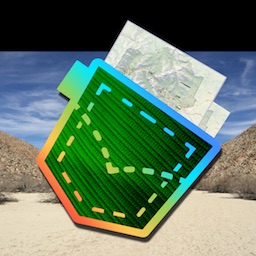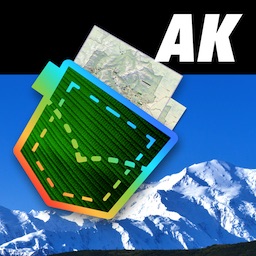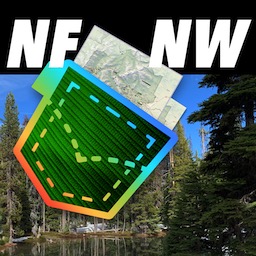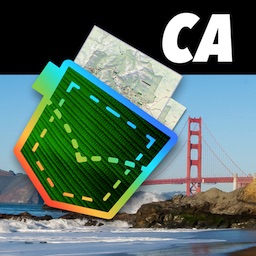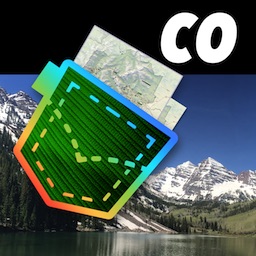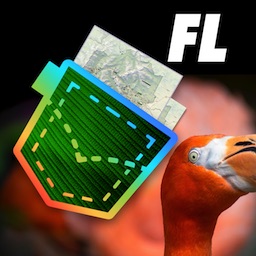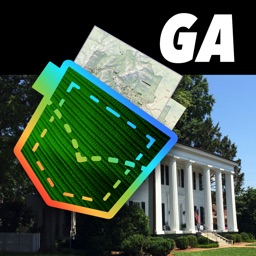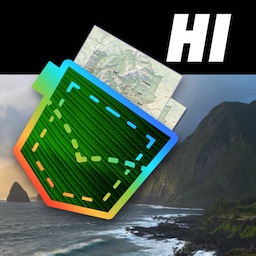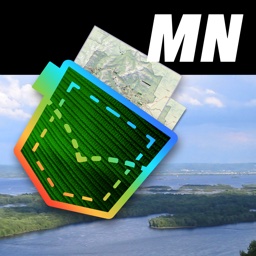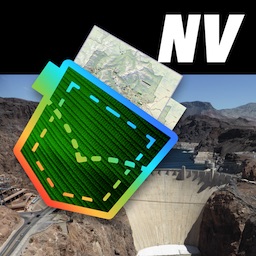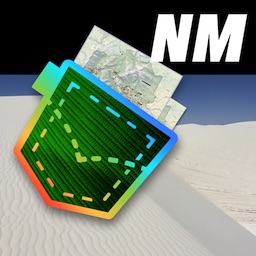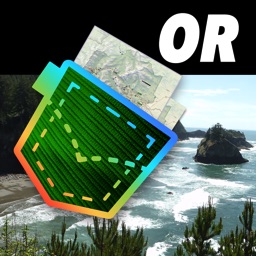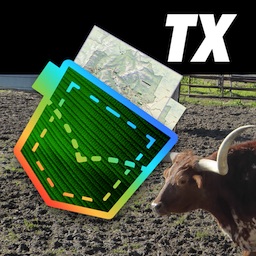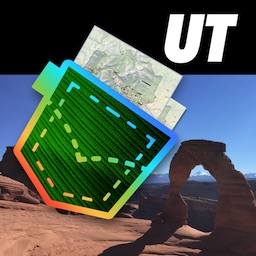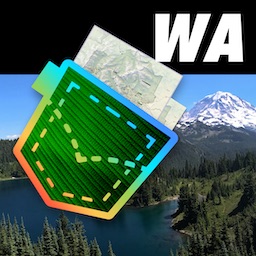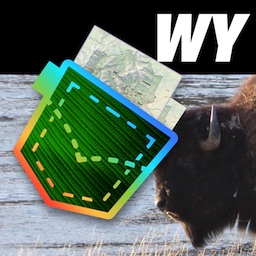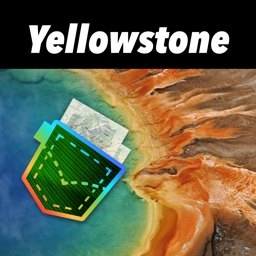"Glacier Bay landscape, Glacier Bay National Park and Preserve, 2015." by U.S. National Park Service , public domain
 | Glacier BayGuide Summer 2022 |
The Summer 2022 edition of The Fairweather Visitor Guide to Glacier Bay National Park and Preserve (NP&PRES) in Alaska. Published by the National Park Service (NPS).
featured in
| National Parks Pocket Maps |  | |
| Alaska Pocket Maps |  |
covered parks
Glacier Bay National Park and Preserve
Summer 2022
V I S I TOR G U I D E
Trails��������������������������page 5
Tlingit Homeland�������page 6
Boating & Camping...page 22
Wildlife�������������������� page 30
Table of Contents
General Information����������������������� 3–13
Explore Glacier Bay highlights
Park Science������������������������������������ 14–19
Discover stories behind the scenery
Glacier Bay Guide�������������������������� 20-21
For boaters, kayakers, and campers
Traveling, Boating & Camping���� 22–29
Plan your adventure
Wildlife��������������������������������������������30–36
Look, listen, and protect
For Teachers������������������������������������������ 37
Share Glacier Bay with your class
For Kids�������������������������������������������������� 38
Become a Junior Ranger
Stay Connected ������������������������������������ 39
Support your park
Additional Information. . . . back cover
Emergency, Medical, and Contact Us
The Fairweather
Produced with assistance from::
Designed by: National Park Service and Alaska Geographic
Park Coordinator: Laura Buchheit
Editor: Sean Tevebaugh
Graphics: Sean Tevebaugh
Contributors: Michael Bower, Laura Buchheit, Brian Buma, Kat
Connelly, Sara Doyle, Lisa Etherington, Chris Gabriele, Margaret
Hazen, Philip Hooge, Emma Johnson, Tania Lewis, Dan Mann,
Sandy Milner, Mary Beth Moss, Janet Neilson, Steven Schaller,
Melissa Senac, Lewis Sharman, Scott Gende, Ingrid Nixon, and
Darlene See.
Special thanks to the following photographers:
Kaytie Boomer, Michael Bower, Brian Buma, Sara Doyle, Janene
Driscoll (inside cover), Chris Gabriele, Tania Lewis, Dan Mann,
Craig Murdoch (front cover), Janet Neilson, Sean Neilson, Steve
Schaller, Sean Tevebaugh, and NPS seasonal staff.
©Alaska Geographic
Welcome to Glacier Bay
Welcome to Glacier Bay
National Park and Preserve,
a park visited each year by
650,000 people, where you
can still kayak for days or
hike for weeks, not seeing
another person. One can
experience Glacier Bay
in much the same way as
a visitor did 50 years ago.
Our goal is for anyone to have the same opportunity
50 years from now. How can that be achieved when
many national parks suffer from crowds, and Glacier
Bay has seen much the same growth in visitation?
The mission of the National Park Service is often
described as a balancing act; “to conserve the
scenery... and to provide for the enjoyment of
the same ... as will leave them unimpaired for the
enjoyment of future generations.” The Huna Tlingit
who have called Glacier Bay homeland for countless
generations (page 6) also have balance - wooch yax
kadál - as a core belief that underlies community
interaction and their relationship with the natural
world.
When I worked as a marine biologist here in the
1990s, the park was engaged with many struggles to
achieve balance. Conflict with the cruise industry
over increased vessel numbers and the impacts
on whales, conflict with the State of Alaska over
jurisdiction of marine waters, conflict with the local
community over commercial fishing, and conflict
with the Huna Tlingit over access and respect for
their homeland. Today we are fortunately in a much
different world, working in partnership with the
cruise industry, the local industry, and the Huna
Tlingit. We have been able to find balance, wooch yax
Visitors to Bartlett Cove experience the wild, glacial landscape of
Glacier Bay.
haaw kawdidáal, among different users of the park,
as well as between experiences and preservation.
Unique among national parks, Glacier Bay has a
complete visitor management system that ensures
that visitors seeking experiences as different as a
ship or solitary kayak can realize these experiences
with the same quality as past generations. This
system is not simple and did not come about easily.
It utilizes science (pages 14-19), respect for many
types of national park experiences, and the constant
question of how to provide for the greatest enjoyment
by the public while preserving the park for future
generations. The park successfully updated its
Frontcountry Plan in 2019, is currently wrapping up
its Backcountry and Wilderness Management Plan,
and will soon begin gathering public input on the
Park’s Marine Managment Plan.
There is a memorial coin underneath each of the four
house posts in Xunaa Shuká Hít (page 6), the Eagle
and Raven totem poles, as well as the healing totem
(page 8). These coins have a statement, engraved in
Tlingit and English, that drive every decision and
every action this park takes:
Haa yátx’i jeeyís áyá
For Our Children Forever.
Philip Hooge, Superintendent
Glacier Bay offers a myriad of opportunities to “Find Your Park.”
3
Explore Bartlett Cove
The shores of Bartlett Cove offer opportunities to explore...
If you just have a few hours...
If you have a half day...
Stop by the Visitor Center: On the second floor of the
Glacier Bay Lodge is the National Park Service (NPS)
information desk and exhibits. Open daily when lodge
is open. Educational materials and souvenirs available
for purchase from Alaska Geographic.
Hike to the Bartlett River: See trail details, page 5.
Walk the Forest Trail: See trail details, page 5.
If you have a full day...
Go for a beach walk: See trail details, page 5.
Explore the intertidal zone at low tide: See map
page 5.
Hike to Bartlett Lake: See trail details, page 5.
Join a Ranger Program: See bulletin boards or park
website for schedule of activities happening during
your visit.
Go for a paddle: There are several options for kayaking
around Bartlett Cove. Take a guided kayak trip, or rent
your own from Glacier Bay Sea Kayaks.
Visit the Whale Exhibit: See one of the largest
humpback whale skeletons on display in the world.
Located near the Visitor Information Station.
Become a Junior Ranger: Kids can pick up their free
Junior Ranger Activity Book from the NPS information
desk at the Glacier Bay Lodge, or from the Visitor
Information Station (VIS). See page 38.
View the Tribal House and the Healing Pole:
Walk along the Tlingit Trail to explore Huna Tlingit
connections to Glacier Bay. See pages 6–8.
Explore Glacier Bay on the Dayboat: Spend the day
exploring Glacier Bay to observe wildlife and tidewater
glaciers. Stop by the lodge for availability*.
Get the Latest Schedule of Events
Please see the NPS Visitor
Center information desk in the Glacier Bay
Lodge, the bulletin board in front of the
lodge, or the Visitor Information Station
(VIS) near the public dock for updates and
information on available services.
4
Trails
Bartlett Cove is the only developed area within
the wilds of Glacier Bay. The forests and
shorelines offer great opportunities for hiking
and exploring. Maps are available at Glacier Bay
Lodge and the Visitor Information Station (VIS).
Forest Trail
Distance: 0.7 miles (1.1 km) one way
Time: 30 minutes–1.5 hours
This leisurely stroll meanders through a lush
forest that grows atop a glacial moraine. A
wheelchair accessible boardwalk takes you part
of the way, leading to two viewing decks that
overlook a serene pond. Return along the shore
for an easy one-mile loop.
Tlingit Trail
Distance: 0.5 mile (800 m) one way
Time: 30 minutes–1 hour
Enjoy this easy stroll along a forested shoreline.
View the Healing Pole and a traditional Tlingit
canoe, admire a complete whale skeleton, learn
about common native plants, and take in the
Raven and Eagle totems, as well as the exterior of
the Tribal House.
Bartlett River Trail
Distance: 4 miles (6.4 km) round trip
Time: 4–5 hours
Explore a dense spruce-hemlock rainforest. The
trail through the forest ends at an estuary near
the mouth of the river. Each summer, spawning
salmon attract otters, eagles, seals, and bears.
Anglers enjoy fishing there, too.
Bartlett Lake Trail
Distance: 8 miles (16 km) round trip
Time: 7–8 hours
About ¾ of a mile down the Bartlett River Trail
you will find the lake trail, a branch trail that
climbs the moraine. This primitive trail is a
rugged day-hike, with rewards of solitude and a
tranquil lake. Bring water, food, and rain gear.
Explore the Shore
Distance: varies
The shoreline beyond the docks continues for
miles past the campground. You may observe
land and marine wildlife. Look for birds, listen
for whales, and watch for sea otters feeding near
shore. This is not a maintained trail.
5
Xunaa Shuká Hít
Xunaa Shuká Hít stands proudly on the shores of Bartlett Cove.
Dressed in the beaded vest of a Tlingit elder, tribal
interpreter Don Starbard shares with visitors: “There’s
a good balance now. Yes, our young people are going
off to college to become successful. But our language
is strong. Our dance is strong. Our canoe culture is
strong, and, most importantly, our connection to
Homeland remains strong.” All summer long, visitors
gather at the Tribal House. They listen to traditional
stories and explore the intricately carved and painted
building. Cultural interpreters working for the National
Park Service (NPS) and the Hoonah Indian Association
(HIA), the tribal government, share deeply of their
traditions, history, enduring connection to Glacier Bay
homeland, and the collaborative efforts that led to the
completion of this magnificent building.
throughout Glacier Bay prior to the Little Ice Age.
Although villages inside the bay were overrun by
glacial advances in the 1700s, the Huna Tlingit reestablished fish camps and seasonal villages soon
after glacial retreat. Establishment of Glacier Bay
National Monument in 1925 (and later National Park)
and implementation of laws and park regulations led
to a period of alienation and strained relationships
between tribal people and the NPS. Time and new
understandings have brought much healing. In recent
years, the NPS and HIA worked cooperatively to
reinvigorate traditional activities, develop cultural
programs for youth and adults, amend regulations to
allow for a broader range of traditional harvests in park
boundaries, and preserve oral histories.
For countless generations, the Huna Tlingit sustained
themselves on the abundant resources found
The most symbolic cooperative venture—Xunaa Shuká
Hít (roughly translated as Huna Ancestors’ House)—
HIA cultural interpreter leads a group down the Tlingit Trail to
Xunaa Shuká Hít.
Hoonah youth welcome traditional dugout canoes on Bartlett
Cove’s shoreline during the 2018 Healing Pole Dedication.
6
Tribal members dance and sing during the August 2016 Tribal
House Dedication.
NPS cultural interpreter shares messages represented within the
Raven and Eagle totems.
now stands proudly on the shoreline of Bartlett Cove.
Dedicated in August 2016 and opened to the public in
summer 2017, it now draws thousands of visitors from
around the world.
sides of Xunaa Shuká Hít. In August 2018, these poles
were joined by Yaa Naa Néx Kootéeyaa (Healing Pole).
This totem, collaboratively designed by NPS and HIA,
reveals the story of the journey through a painful past
to a healthier, more meaningful partnership. Xunaa
Shuká Hít is a place of learning, growth, inspiration,
and continued healing for generations to come.
A team of clan leaders, craftsmen, planners, architects,
and cultural resource specialists designed Xunaa
Shuká Hít to reflect a traditional architectural style
reminiscent of ancestral clan houses with modern
touches suitable for the needs of the community today.
Inside the Tribal House are four richly detailed massive
cedar interior house posts and an interior house screen
which depicts the stories of the four primary Huna
Tlingit clans and their tie to Glacier Bay homeland.
These cultural elements impart spiritual value to the
Tribal House, and, as importantly, their design and
completion expand the circle of tribal members who
hold traditional skills and share in cultural knowledge.
The 2,500 square foot Tribal House is not only a place
for visitors to learn about Tlingit traditions, but is
also a venue for tribal members to reconnect with
their traditional homeland, life-ways, and ancestral
knowledge. Within months of its dedication, the Tribal
House inspired native high school students to spend
their winter school break at the Tribal House learning
traditional crafts from elders and culture bearers.
Months later, hundreds of tribal members gathered
to raise the Eagle and Raven totems that grace the
Images of the Huna Tribal House dedication and
carving projects are available on the park’s website
under the Tribal House Media Gallery. To learn more
about special events and opportunities to experience
the Tribal House, check the posted activity schedules in
Bartlett Cove or ask a ranger.
Traditional songs inspire the strength and stamina to carry the
Raven and Eagle totems at the May 2017 Totem Raising.
7
Yaa Naa Néx Kootéeyaa
I believe we are on a path - that our people will be remembered...”
- Frank Wright Jr, President of Hoonah Indian Association
Our pole...is a story pole. It is, essentially,
the recorded history, not only of the Huna
Tlingit, not only of Glacier Bay National
Park, but of our long, sometimes painful,
sometimes joyous, journey together.
- Philip Hooge, Superintendent
Journey of Healing
Philip Hooge (left) and Frank
Wright, Jr. (right) at the Healing Pole
Dedication.
Raised on August 25, 2018, Yaa Naa Néx Kootéeyaa (Healing Pole) tells
the story of the long journey for both Huna Tlingit and the National
Park Service to heal years of misunderstandings and hurt.
Designed collaboratively by tribal elders, carvers, and NPS staff,
the pole contains a mix of traditional formline design and modern
representations of symbols—differentiating it from other poles in
Southeast Alaska.
Glacier Bay is the traditional
home and “breadbasket” of the
Huna Tlingit—sustaining them
physically and spiritually until a
rapidly advancing glacier pushed
them out in the late 1700s.
The Huna Tlingit felt that the
federal government—a faceless,
soulless being with too many
hands—barred them from many
traditional practices upon their
return after the glacier receded.
Traditional dugout canoes
support healing journeys
cooperatively planned by
NPS and the Hoonah Indian
Association—connecting tribal
members with Glacier Bay
homeland.
Visit the Healing Pole next to the Visitor Information Station,
and read the complete story from bottom to top at our website:
go.NPS.gov/HealingTotem
8
Planning for our Park
The National Park Service cares
for special places saved by the
American people so that all may
experience our heritage.
Glacier Bay by satellite, from NASA’s Earth Observatory.
Your Opinion Counts
You are a part of a long legacy of adventurers inspired by
Glacier Bay! Keep connected and involved even from afar.
The NPS relies on your feedback to help guide stewardship
of America’s great natural and cultural resources.
Glacier Bay National Park is currently working with the
NPS to update some of the park’s management plans. This
planning effort will strengthen the park service mission
to provide for visitor enjoyment while also preserving the
park’s extraordinary natural and cultural heritage for
future generations.
Please take the time to visit our Frontcountry and
Backcountry Management Plan websites (see below) or
contact us (see right) to learn more about our process and
progress, and to offer your unique perspective. There are
multiple ways you can be involved.
Follow implementation of the
updated Bartlett Cove plan:
go.nps.gov/GLBA_FMP
Frontcountry Management
Plan website
Follow Glacier Bay wilderness
experience planning:
go.nps.gov/GBwild
Backcountry Management
Plan website
Stay Tuned!
You don’t need to live close by to be connected
and stay involved. You can follow progress and
offer feedback to inform park planning in the
following ways:
√ SUBSCRIBE to our planning notification list
by sending us your contact information:
glba_public_comments@nps.gov
Glacier Bay National Park & Preserve
PO Box 140
Gustavus AK 99826
√ FOLLOW the park’s social media for press
releases and planning announcements (public
meetings, review drafts, comment periods).
√ VISIT US ONLINE to learn more about
park management: https://www.nps.gov/glba/
getinvolved/planning.htm
Visit the NPS online portal for real time public notices and comment
opportunities: Planning, Environment, and Public Comment (PEPC)
https://parkplanning.nps.gov/glba
9
Timeline of Glacier Bay
1980 Congress, under
1794 Captain George
Since time immemorial,
Tlingit clans live in the area that
is now Glacier Bay. Advancing
glaciers in the 1700s during the
Little Ice Age force the Tlingit
out of their homeland. After
the Little Ice Age, the glacier
melts back and the ocean fills
the valley quickly, creating
Glacier Bay.
1750
1770s–1790s
European explorers arrive.
Excursions led by Captains
Malaspina, La Perouse, Cook,
Vancouver, and many others
provide the first western
descriptions of the area and its
people. Cartographers create
the first maps of the area and
non-Native names are given to
landforms.
10
Vancouver of the H.M.S.
Discovery and Lt. Joseph
Whidbey describe Glacier
Bay as “a compact sheet of
ice as far as the eye could
distinguish.” The “bay” is a
mere five-mile indentation
in the coastline.
1800
1925 Ecologist William
1883 James Carroll and other
commercial steamship captains
make Muir Glacier a popular
tourist destination.
1850
1900
Park Service and Hoonah
Indian Association
sign a Memorandum of
Understanding to establish
a working partnership.
1950
1916 U.S. Congress passes
the Organic Act, creating the
National Park Service.
part of the “Mission 66” initiative
that brought facility improvements
to national parks nationwide during
the 50th anniversary of the National
Park Service.
2022 Reduced
park operations
due to the Covid-19
pandemic sees
approximately
68,434 visitors. In
2019, Glacier Bay
welcomed over
640,000 visitors.
2000
2016 The National
1966 Glacier Bay Lodge opens as
1879 John Muir, guided by Tlingit
men, paddles into Glacier Bay. They
find the glacial ice has retreated 40
miles since 1794. Muir returns three
times over the next 15 years. He
constructs a cabin, makes extensive
observations of glaciers, and
explains interglacial tree stumps.
The eloquent writings of enthusiasts
like Muir and Eliza Scidmore begin
attracting new visitors to the bay.
S. Cooper, studying plant
succession in Glacier Bay,
and the Ecological Society
of America persuade
President Coolidge to
establish Glacier Bay
National Monument.
the leadership of President
Jimmy Carter, signs the
Alaska National Interest
Lands Conservation Act
into law. Glacier Bay
becomes a national park
and preserve encompassing
3.3 million acres.
1995 The National
1992 UNESCO designates
Glacier Bay, along with
Wrangell-St. Elias National Park
and Preserve (Alaska), Kluane
National Park Reserve (Canada)
and Tatshenshini-Alsek
Provincial Park (Canada), as a
24-million-acre World Heritage
Site, one of the world’s largest
internationally protected areas.
Park Service celebrates
its centennial: 100 years
of “America’s Best Idea.”
Glacier Bay celebrates
with the opening of the
Huna Tribal House, a
collaborative project
with the Hoonah Indian
Association. The building
serves as a cultural anchor
and a place of learning.
11
World Heritage
A cruise ship appears small within the expansive Glacier Bay landscape. Through careful vessel management, Glacier Bay National
Park seeks to balance visitation with resource preservation.
International Connections
A cruise ship sails into Glacier Bay, one of potentially only
two for that summer’s day. The ship’s company follows
voluntary environmental protocols to reduce vessel
emissions and lower impacts. The ship’s crew curtails
activities aboard, encouraging passengers to take in the
wilderness around them. Interpretive rangers, invited
aboard for the day, share stories of the park and its
significance. After visiting the tidewater glaciers, the ship
eventually departs leaving nothing but its wake.
the 50 marine sites on the United Nations Educational,
Scientific, and Cultural Organization (UNESCO)
converged on Bartlett Cove for a symposium with
one major goal: to learn from each other how to best
manage their protected areas. Over the five-day event,
managers from sites all over the world shared stories of
the challenges they face including increasing visitation,
climate change, and marine pollution. They also shared
solutions.
This Glacier Bay model of vessel management is a
significant reason why in September 2019, managers of
According to Superintendent Philip Hooge, the
gathering was a chance to highlight the park’s
success with public-private partnerships. “Working
together with the cruise industry we have been able
to successfully deal with some of the issues associated
with cruise tourism,” he said, “and achieve higher
environmental standards using means other than the
regulatory process.”
Park Superintendent and West Norwegian Fjords Board
Chairman sign Sister Park Agreement at Lamplugh Glacier.
12
While in the bay in front of the Lamplugh Glacier with
the marine managers cheering on, Superintendent
Hooge signed a Sister Park Agreement with
representatives of West Norwegian Fjords World
Heritage Site in Norway. The two sites have much in
common in that they both feature scenic fjords with
major visitation by cruise ships. “This provides an
incredible opportunity for protected areas that share so
much to learn from each other,” said Hooge.
Glaciers
A glacier flows from the Fairweather Mountains. Glaciers continue to change in response to their environment.
Rivers of Ice
Tall, coastal mountains and an abundance of snow
make Glacier Bay a comfortable home for hundreds of
glaciers. Storms from the Pacific Ocean collide with the
towering Fairweather Mountains, often producing rain
at sea level and snow at higher elevations. More snow
falls each year than melts in the mountains. The snow
compacts, forming ice. With the influence of gravity,
the ice slides down the mountainside. Basically, ice in
motion is a glacier.
As a glacier flows down the mountainside, it reaches
warmer elevations. When the air above a glacier is above
freezing or if it is raining, then ice melts. The balance
between the amount of ice forming and ice melting
determines whether a glacier advances (grows) or
retreats (shrinks), though it always flows forward.
Glaciers shrink in size when more ice is lost from melting than
gained from snowfall.
“Words and dry figures can give one little idea
of the grandeur of this glacial torrent flowing
steadily and solidly into the sea, and the beauty
of the fantastic ice front, shimmering with all the
prismatic hues, beyond imagery or description.”
-Eliza Scidmore, 1883
A few glaciers, called tidewater glaciers, reach all the
way to the ocean and are strong enough to survive
with their ice touching warm ocean water. Tidewater
glaciers have a naturally occurring cycle of advance
and retreat that has shaped Glacier Bay for millennia. A
few hundred years ago, a glacier that sat mid-way down
the bay for centuries advanced rapidly until it came to
the waters of Icy Strait. The salty ocean water caused
the glacial ice to melt and dramatically break away in
a process called calving. Snowfall couldn’t keep up
with the amount of melting and calving, so the glacier
retreated quickly. All of the glaciers visitors see in the
park today are remnants of that once large glacier.
Changes to glacial ice continue in Glacier Bay. While
tidewater glaciers are still influenced by ocean water,
all glaciers are now impacted by a rapidly warming
planet. Glacier Bay National Park will continue to study
glaciers as the climate warms. As a living laboratory,
Glacier Bay provides outstanding opportunities to
explore the intricate dynamics of glaciers.
13
Park Science
Visitors and researchers alike from around the world
explore and admire Glacier Bay. The dramatic retreat
of glaciers created a premiere scientific laboratory.
Explorer John Muir initiated the park’s remarkable
legacy of scientific inquiry in the late 1800s. Botanist
William Cooper secured protected status for Glacier
Bay following his research about how plant life
follows glacial retreat. In fact, the initial proclamation
protecting Glacier Bay National Park states research
as a reason for national preservation. From whales and
plankton to climate and otters, research is a common
occurrence in the protected laboratory of Glacier Bay.
This scientific study provides greater understanding
and appreciation for the wilderness we explore. Learn
more by reading the following pages, and make your
own discoveries in Glacier Bay.
“The most beautiful thing we can experience
is the mysterious. It is the source of all true art
and science.”
- Albert Einstein
Kiana continued working as a wildlife technician in
Glacier Bay where she assisted in a variety of wildlife
research and management projects including nesting
seabird monitoring, assessing the impact of land-based
tourism on wildlife by setting up remote cameras, and
bear monitoring and management.
Kiana Young frequently conducts backcountry wilderness
patrols in Glacier Bay. Pictured here at McBride Glacier.
Meet a researcher
Kiana Young, Biologist
Growing up in national parks, Kiana spent her free
time exploring the woods and looking for creatures in
tidepools. These experiences ignited her passion for
nature and wildlife which persists today.
Kiana studied Wildlife Conservation at the University
of Washington; during that time, she first started
working for Glacier Bay as a student hire. She did her
senior project on the composition and interactions of
scavengers on a humpback whale carcass on the shores
of Glacier Bay. After finishing her bachelor’s degree,
14
Kiana went back to school for her master’s degree at
Trent University. Her research focused on mountain
goats in Glacier Bay, focusing on the population
genetics, demographic history, and predicted response
to climate. Over two summers, she climbed mountains
througout Glacier Bay National Park collecting
mountain goat pellet samples. Kiana took these
samples back to the genetics lab at Trent University
where she extracted and genotyped the DNA. With
this information she was able to identify the number
of genetically distinct mountain goat subpopulations
within the park, examine the patterns and general
time periods that different subpopulations split from
one another, and generate predictions of the trajectory
of these mountain goat populations in the future as a
result of climate change.
Kiana considers herself fortunate to have been
surrounded by incredible family, friends, coworkers,
and mentors throughout her life who have helped
her realize and follow her passions as a career. She
hopes to continue this career in wildlife biology
conducting research, providing input for management
decisions, and helping others, especially historically
underrepresented groups, find their passion for nature
and wildlife.
William S. Cooper recognized Glacier Bay as a living laboratory. He studied the process of pioneer plants colonizing land recently
revealed by retreating glaciers.
A Vision of Preservation
People visit Glacier Bay to view amazing scenery,
dramatic glaciers, and spectacular wildlife. Yet a
century ago one man saw something else of great value
here: incredible opportunities for science.
monument. One of the monument’s fundamental
mandates was to preserve the opportunity to conduct
scientific studies, making Glacier Bay a true “park for
science.”
Botanist William Skinner Cooper (1884–1978) came
to Glacier Bay in 1916 to study how plants colonize
newly-exposed ground following glacial retreat. He
recognized Glacier Bay as the best place on earth to
witness the process of “plant succession,” a fascinating
interplay of plants, nutrients, soil, and time. In this
process the bare ground emerging from beneath a
glacier goes through various stages to become a rich,
thick, mossy evergreen forest of towering spruces and
hemlocks.
Dr. Cooper returned to his beloved Glacier Bay many
times to document the successional development in the
study areas and plots he established on his first visit.
Dr. Cooper’s students and other scientists continue his
work on how ecosystems respond to glacial recession
and, more broadly, global climate change. This ongoing
research makes Glacier Bay the oldest continuously
researched post-glacial landscape in the world.
Dr. Cooper saw a natural laboratory in Glacier Bay
where scientific principles could be discovered as
well as tested; a place where completely new scientific
questions could be asked. As a prominent member
of the Ecological Society of America, Dr. Cooper
successfully led a committee of colleagues in a vigorous
campaign to lobby President Calvin Coolidge for
protection of the Glacier Bay area in 1925 as a national
Glacier Bay is preserved
as public land for many
reasons: protection of
wildlife habitat, scenery,
value to the world,
enjoyment by present
and future generations,
and as a living laboratory.
Glacier Bay still inspires
new discoveries today.
Ecologist Brian Buma continues
the legacy of research on
Dr. Cooper’s original plots.
From rock to rainforest—in just 75 years! Images taken at the same location document the landscape changes.
15
Park Science
Ninety-five percent of Alaska’s glaciers are thinning, stagnating, or retreating.
The Ice Is Melting
The Earth’s climate is changing—and fast! In
Glacier Bay, glaciers are rapidly shrinking and ocean
temperature is rising. Scientists who study the Earth’s
climate have documented warming temperatures in
Alaska due to increased carbon dioxide levels. Warming
temperatures lead to changes in fire cycles, tree growth,
animal migrations, and rapidly melting glaciers.
Ninety-five percent of Alaska’s glaciers are currently
retreating, thinning, or stagnating. Importantly, the
rate of thinning is increasing. Glacier Bay’s glaciers
follow this trend. Recent research determined that
the area covered by ice in Glacier Bay has shrunk 15%
from 1950 to now. Nevertheless, heavy snowfall in the
towering Fairweather Mountains means that a few
glaciers might remain stable in Glacier Bay, a rarity in
today’s world. Take a good look at the glaciers you see in
Glacier Bay today. The next time you see these glaciers,
they will be different.
Alaska and other polar regions experience the effects
of climate change more strongly than other places.
Decades of data from NASA’s Goddard Institute for
Space Studies show that Alaska and the polar regions
have warmed more than twice as much as the rest of
the earth. Climate change is a reality for Alaskans,
threatening villages with coastal erosion, changing
subsistence practices, and altering weather patterns.
Ask park rangers about what changes they have noticed
in Glacier Bay.
16
There is good news. Humans are inventive, resourceful,
and capable of overcoming great challenges. Although
climate change is a global concern, we each hold a part
of the answer to minimizing its impact.
The Earth’s climate is changing and Glacier Bay is
warming. How will these changes affect you? One
fact is certain: the choices we make today will make a
difference in the future.
For more information about climate change in national parks,
visit www.nps.gov/climatechange
Aerial photography is used by National Park Service scientists to monitor harbor seal populations.
Seals as Sentinels of Ice Dynamics
In tidewater glacier fjords, harbor seals’ lives are tied to
readily available glacial ice.
calving dynamics of tidewater glaciers may influence
ice availability in Johns Hopkins Inlet.
Tidewater glaciers are the source of vital habitat for
harbor seals (Phoca vitulina richardii). Icebergs calved
from glaciers serve as pupping, molting, and resting
habitat for some of the largest seasonal gatherings of
harbor seals in the world. Glacier Bay, specifically Johns
Hopkins Inlet, hosts one of the largest aggregations of
ha
